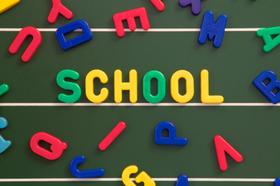Manchester Regional Day School serves 64 students in grades Prekindergarten-12.
The student:teacher ratio of 5:1 is lower than the New Jersey state level of 11:1.
Minority enrollment is 66% of the student body (majority Hispanic), which is higher than the New Jersey state average of 62% (majority Hispanic).
Quick Stats (2025)
- School Type: Special education school
- Grades: Prekindergarten-12
- Enrollment: 64 students
- Student:Teacher Ratio: 5:1
- Minority Enrollment: 66%
- Source: National Center for Education Statistics (NCES), NJ Dept. of Education
Top Rankings
Manchester Regional Day School ranks among the top 20% of public schools in New Jersey for:
Category
Attribute
Community Size
Student Attention
School Overview
Manchester Regional Day School's student population of 64 students has declined by 5% over five school years.
The teacher population of 13 teachers has stayed relatively flat over five school years.
School Type
Grades Offered
Grades Prekindergarten-12
Total Students
64 students
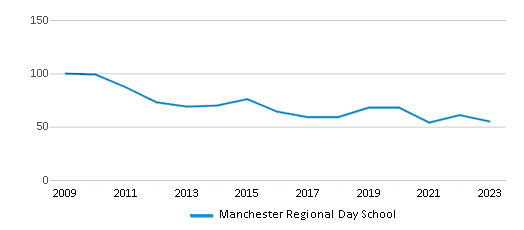
Gender %
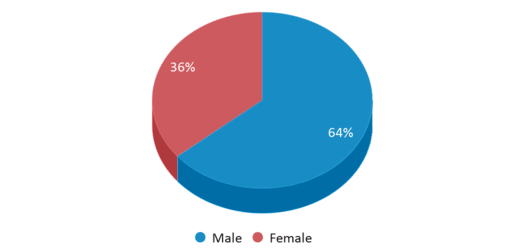
Total Classroom Teachers
13 teachers
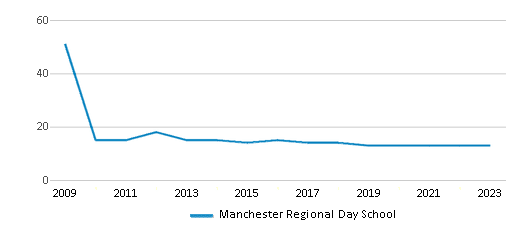
Students by Grade
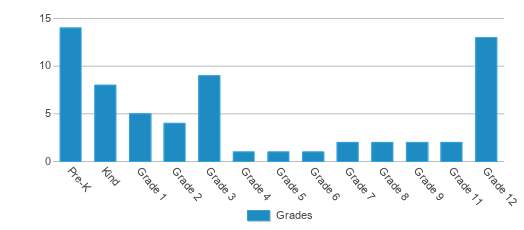
School Rankings
The diversity score of Manchester Regional Day School is 0.66, which is less than the diversity score at state average of 0.72. The school's diversity has stayed relatively flat over five school years.
Student : Teacher Ratio
5:1
11:1
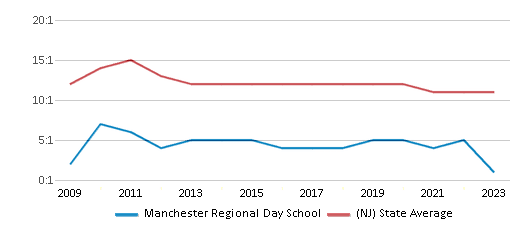
American Indian
n/a
n/a
Asian
2%
10%
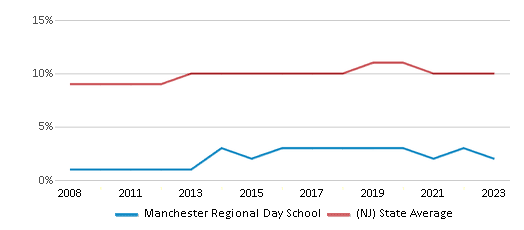
Hispanic
44%
34%
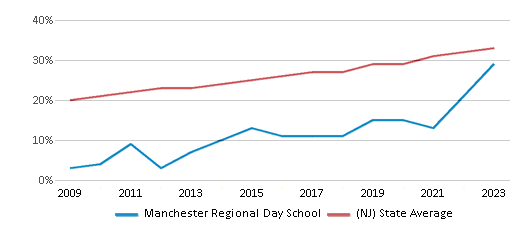
Black
19%
15%
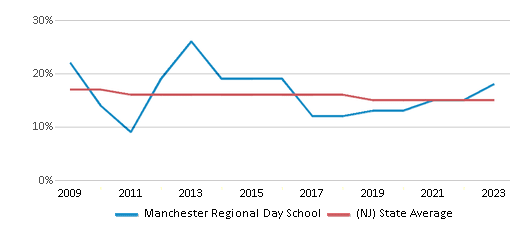
White
34%
38%
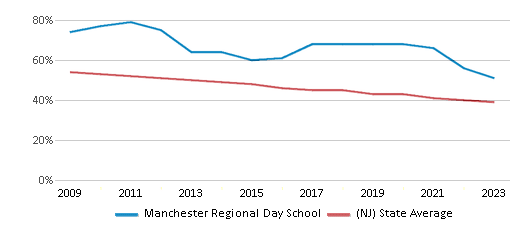
Hawaiian
n/a
n/a
Two or more races
1%
3%
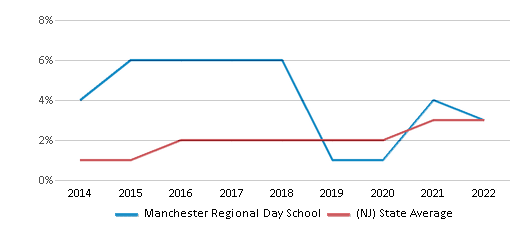
All Ethnic Groups
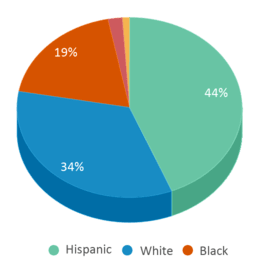
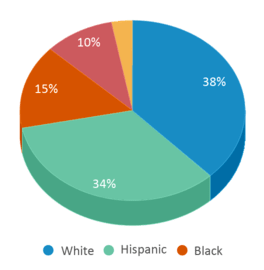
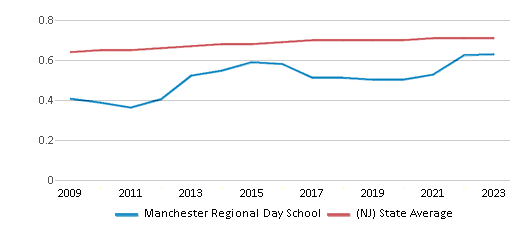
Participates in the National School Lunch Program (NSLP)
Yes
Eligible for Free Lunch
33%
32%
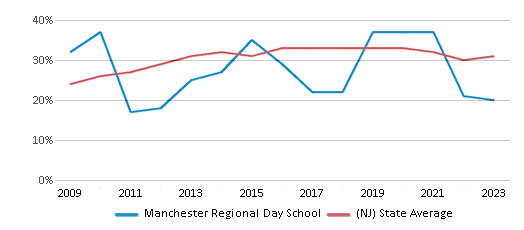
Eligible for Reduced Lunch
5%
6%
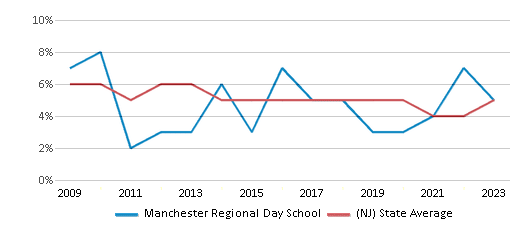
School Statewide Testing
School District Name
Source: National Center for Education Statistics (NCES), NJ Dept. of Education
Frequently Asked Questions
What schools are Manchester Regional Day School often compared to?
Manchester Regional Day Schoolis often viewed alongside schools like Academy Learning Center by visitors of our site.
How many students attend Manchester Regional Day School?
64 students attend Manchester Regional Day School.
What is the racial composition of the student body?
44% of Manchester Regional Day School students are Hispanic, 34% of students are White, 19% of students are Black, 2% of students are Asian, and 1% of students are Two or more races.
What is the student:teacher ratio of Manchester Regional Day School?
Manchester Regional Day School has a student ration of 5:1, which is lower than the New Jersey state average of 11:1.
What grades does Manchester Regional Day School offer ?
Manchester Regional Day School offers enrollment in grades Prekindergarten-12
What school district is Manchester Regional Day School part of?
Manchester Regional Day School is part of Manchester Township School District.
School Reviews
5 9/12/2012
Regional Day School is one of a kind. I would recommend this school hands down. I only wish we came here earlier but because we came from another district, we missed some very important milestones that I think my son could have achieved if he were in this school .
Review Manchester Regional Day School. Reviews should be a few sentences in length. Please include any comments on:
- Quality of academic programs, teachers, and facilities
- Availability of music, art, sports and other extracurricular activities
Recent Articles

Teaching in Contemporary Times
We explore why individuals choose teaching, illuminating intrinsic motivations, the influence of role models, the pursuit of lifelong learning, and the aspiration to impact society.
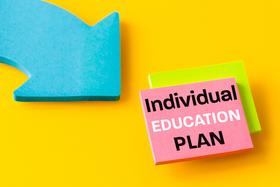
Demystifying IEPs
Unlock the power of Individualized Education Programs (IEPs) in this comprehensive guide. Discover how IEPs support students with diverse needs, including behavioral challenges. This article is a must-read for parents navigating the education system and aspiring teachers seeking to make a positive impact.

December 16, 2024
Personalized Learning: Revolutionizing Education for the 21st CenturyExplore the revolutionary approach of Personalized Learning in K-12 education. This article discusses the benefits, challenges, and potential of tailoring education to individual student needs, incorporating technology and adaptive learning methods to prepare students for the 21st century.



